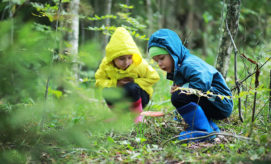During the first five years of life, young children are learning a variety of skills that they will need in order to be successful in elementary school and beyond. Certain foundational skills, including the ability to analyze, problem solve, communicate, and understand meaning are known collectively as critical thinking skills. In this article, we explore what critical thinking skills are, why they are important, and how educators can support children’s foundational critical thinking skills.
What Are Critical Thinking Skills?
Critical thinking skills are the skills that we use to observe the world around us, seek out new information, and organize what we know to make informed decisions. In an article published at Michigan State University, early childhood educator and content developer Kylie Rymanowicz explains that “these incredibly important (critical thinking) skills are used in everything from putting together puzzles to mapping out the best route to work. It’s the process of using focus and self-control to solve problems and set and follow through on goals. It utilizes other important life skills like making connections, perspective taking, and communicating.”
Critical thinking can power new and creative solutions. For example, gathering new information and comparing it to what we already know helps us deepen our understanding of a situation and opens the door to fresh perspectives and innovative approaches.
Why Are These Skills Important for Early Learning?
Young children are eager to observe and make sense of the world around them. Introducing early learners to critical thinking approaches helps them build foundational skills that later equip them to become lifelong learners.
-
Critical thinking skills support language development. An article from the early language and literacy non-profit Hanen Centre explains that “as children engage in critical thinking, their language skills expand because they’re encouraged to develop and use more complex language” As young children think critically about the world around them, they ask questions and make observations that introduce them to new words, concepts, and ideas. Children are likely to be inspired to share their new understandings with their peers, sparking deeper conversations and supporting the development of communication skills.
-
Critical thinking skills support foundational mathematical skills. Critical thinking skills help children recognize patterns and think about how shapes work together. Considering math basics in new ways enables children to look at more complex problems and tap into different approaches to problem-solving.
-
Critical thinking encourages creativity. When children attempt to solve a problem, they use critical thinking skills to evaluate the situation and brainstorm new solutions. This requires the use of creativity to consider a problem in new ways before testing out potential solutions.
How can Educators Support Development of These Skills?
Critical thinking follows a developmental path, meaning that it emerges in children over time as they learn and grow. As early learning professionals, we can support this development by promoting the use of critical thinking skills in our work with young children. Following are a few suggestions for building critical thinking into early learning activities.
-
Encourage Problem Solving
When children are working on a project or activity, give them opportunities to work through problems on their own before you offer solutions. For example, ask questions like: “What other ways could we do this?” “Do you have different ideas about how we might make this work?” “What do you think would happen if…?”
2. Invite Creativity During Storytime
While reading a story with the children in your care, pause partway through the book and encourage them to think about alternate endings: “What might the main character do?” “How might they solve their problem?” “What are some different ways that the story could end?”
3. Play Mystery-Solving Games
Invite children to play pretend games in which they are detectives trying to solve a mystery. Some fun mysteries to solve could include…
-
How do flowers grow? Set up an experiment to learn about how plants grow and encourage children to make guesses about how much sun or water the plants will need.
-
What’s in the box? Set up a box and place an object inside of it. Encourage children to guess what’s in the box by shaking, feeling, and smelling the item before they get to look inside. Each item placed in the box becomes a new mystery to investigate.
-
What is the picture? Print out photos and cut them into different pieces, so that children can put them together like a puzzle. Ask the children what they think the picture might be before they put the pieces together.






